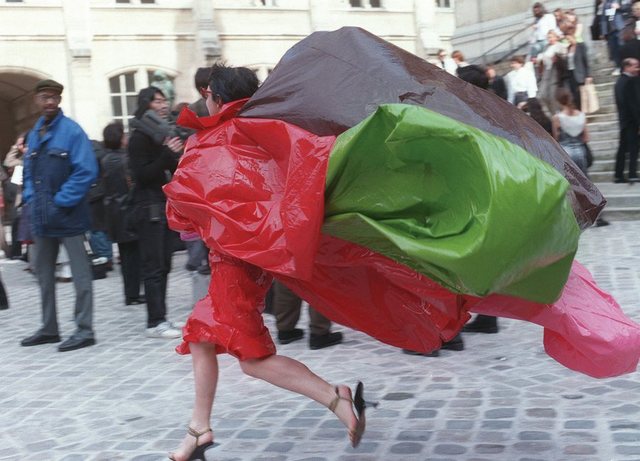
image of Isabella Blow in Yoshiki Hishinuma, by bill cunningham, via nyt 2002
“To be contemporaine de tout le monde–that is the keenest and most secret satisfaction that fashion can offer a woman.”
– The Arcades Project, Walter Benjamin
Apparent egalitarianism is the great appeal of the Street Fashion concept, especially in New York, and especially in the street photos of Bill Cunningham in the NYTimes. If you just be yourself –and that self is someone who’s got a bit of the trend radar that puts you in cargo pants about six weeks before it shows up in Cunningham’s Sunday street collages– your embroidered jeans-wearing booty may just surprise you by turning up in the paper. Bill never put your name under your photo, not even if yours is recognizable; credit goes to the man with the camera, and your just appearing is reward enough.
But when someone like Isabella Blow –who’s got “Muse” printed on her carte de visite –walks down the street, it’s the street fashion equivalent of George Bush making a speech in a national park: the setting says “See, I < heart > nature,” but be surprised if the clearcutters wait till FoxNews cuts back to the studio before revving up their chainsaws. Blow’s not on just anyone on any street any time. She’s a Muse. In Paris. During The Shows. Walking (or wafting, in this case) amidst photographers, designers, editors, stylists, and groupies. Fashion industry types. Just like her.
One of the designers Blow muses for is Jean-Paul Gaultier, who I once sat next to on the Concorde [that was totally uncalled for, I know]. Nice guy. And a brilliant miner of both the street-as-walkway and the street-as-runway. The Mixture, a new culture site with an old-school appreciation of editing, is streaming Gaultier’s latest show in its entirety. It’s worth watching.
Benjamin called the flaneur “a spy for the capitalists, on assignment in the realm of consumers.” If so, in the lead of France’s fashion industry (an “occult science of industrial fluctuations” if ever there was one. The Arcades Project is like a can of Pringles: once it’s open, you can’t stop at just one.) is just where Gaultier belongs.
France’s fashion week definitely has an industrial air, with trade associations, official this and that, and weighty government sanction. It’s like the Expositions Universelles that made Paris the center of the 19th century world, where innovations were unveiled: things like “electricity” (“The City of Lights”) and “Photography,” which debuted there in 1855. Benjamin again, on the group that re-defined the term, avant-garde:
The Saint Simonians, who envision the industrialization of the earth, take up the idea of world exhibitions…[They] anticipated the development of the global economy, but not the class struggle…World exhibitions glorify the exchange value of the commodity.
Nice work, if you can get it. Nobody knows better than Benjamin that the image and (the street) reality have a very complicated (business) relationship. When Bill Cunningham takes Isabella Blow’s picture on the street in Paris, we have to know that the image is manufactured, constructed in a myriad of ways, some obvious and some not, by all parties involved. (Isabella, even the panhandling woman in my neighborhood changes into her garbage bag before starting work.)
And I found the same issues face the filmmaker, even/especially the documentary filmmaker. To what extent do you just “let something happen” and you “happen” to film it? To what extent to you “make something happen,” or stage it? Can’t stage it? Wouldn’t be prudent? Wouldn’t have street cred? Well, how about if you just go to the spots where you know what you want to shoot is gonna happen? Then, you can just “happen” to film it. It all involves choices; editing before, during, and after the fact; having an eye (and a camera), and deciding what to do with it. All things being equal, then, some things just look better. And that can make all the difference.
The Age of Street Fashion [nyt]



